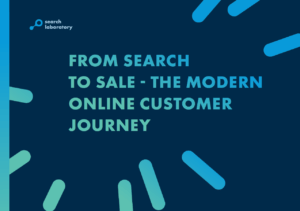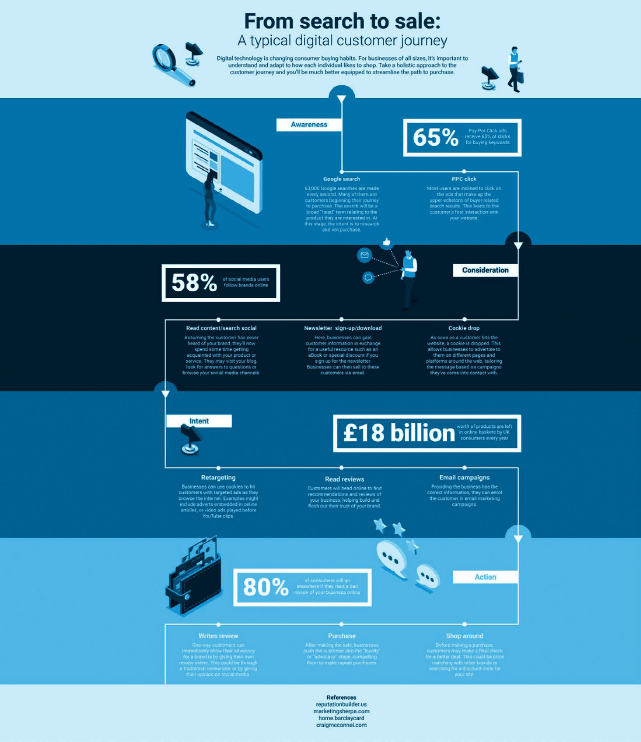A significant challenge which marketers face is truly getting into the minds of their customers. Learning the sentiments, intentions, opinions and personalities of those who engage, and who you want to, with your business online can help you to create a digital marketing strategy that improves customer acquisition, customer loyalty and online conversions.
Depending on where a potential lead is in the customer journey, the different factors that influence their decision to move through the buying funnel can vary significantly.
Th is process is further confused by the development of technology – the customer buyer journey is no longer linear, and an individual may move up, down and sideways through the customer buyer journey before making a purchase.
is process is further confused by the development of technology – the customer buyer journey is no longer linear, and an individual may move up, down and sideways through the customer buyer journey before making a purchase.
What are the challenges brands face in the changing world of customer journeys? How do brands define their own? Download our in-depth whitepaper to find out more.
Technology changes the way we shop. Since the first online shopping transaction took place in 1994, its influence on each stage of the customer journey has grown.
Today, improvements in network connectivity and the rise of smartphones means our lives are now dominated by mobile technology; the average person checks their smartphone 52 times a day! Having such easy and instant access to the internet allows consumers to better inform themselves on products before making a purchase.
For brands, it highlights the importance of a mobile-first customer journey: 40% of consumers now prefer to do their entire shopping journey on their smartphone, a fact which has been recognised by Google’s March 2018 update which indexes the mobile version of a page first. Brands must adapt, ensuring their site is fully optimised for mobile purchases, if they are to maintain their online visibility.
Another example, this time from further up the funnel, is online reviews: as many as 91% of people read reviews online before making a purchase, highlighting the power technology has in social proofing. For brands, the difference between pushing a customer through the “consideration” phase and into “intent” could depend on the existence and strength of your online reviews.
Depending on the product, service, and industry, each business’ customer journey will differ in a variety of ways. However, the process of defining it requires the same three steps: personas, touchpoints, and mapping.

Customer personas are fictional representations of a business’ customers. Using qualitative and quantitative data, personas outline some of the characteristics and situational realities of their customers.
How much money do they earn? Are they a parent? Do they own their own home? What are their hobbies and interests?
Mix your personas with touchpoints to meet your customers where they like to interact with your product. A touchpoint is somewhere online where you interact with customers; paid ads, SERPs, social media, review sites are all potential touchpoints.
Once you have identified exactly who your customer is, and what touchpoints they interact with, you’ll be better equipped to influence them on their purchasing journey. Using data-driven attribution will help you to identify these touchpoints, and assign how much power they have in the customer journey.
Combine the two stages above and then begin mapping your online customer journey. Creating a journey for each customer persona, the map takes each stage of the conversion funnel and asks a series of questions: what are their goals at this stage of the purchasing cycle? What emotions will they be feeling? What touchpoints will they be using?
Customer journey mapping can help to unblock customer pain points. If your tone and medium of engagement don’t fit with the needs of the customer at that phase of the journey, you’ve outlined an area for improvement.
In business, the importance of data is growing. Whilst it’s always been a valuable asset, the ease at which businesses can access and make insights from data is improving. Rather than relying on gut instinct, data now informs our marketing decisions. When dealing with a subject as complex as the customer journey, data really is a necessity.
Thanks to advanced analytics platforms such as Google Analytics 360, data-driven attribution models are becoming more sophisticated. Identifying the true value of each channel (rather than just the last channel each customer encountered before purchase) allows us to make informed marketing decisions that will push prospects through the customer journey.
In our latest whitepaper, we cover the modern online customer journey in more detail. Laying out the influence of more emerging technologies and using infographics to outline how your typical customer will progress from research to purchase, our guide to the online customer journey is available to download now.